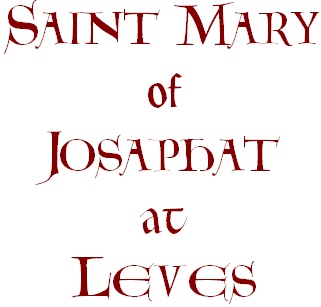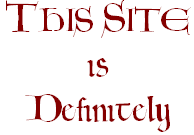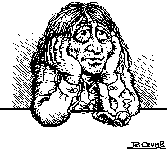

| The EARLY HISTORY
of the Abbey The Benedictine abbey of Saint Mary, called, from its inception, "of Josaphat," was founded (apparently) in 1117 by Bishop Godfrey II of Chartres and his brother, Goslen, the Dominus of Lèves, on their ancestral lands just below the castrum of Lèves, in the valley of the Eure, a few kilometers downstream from Chartres. A local tradition had it that, upon the death of Bishop Ivo (in late 1115) Archdeacon (as he then was) Godfrey was elected his successor and, perhaps, consecrated. In 1116 he undertook a pilgrimage to Rome for the purpose of obtaining from Pope Pascal II a release from an earlier vow which he had made to go to Jerusalem. (Another source has it that Godfrey had indeed taken a vow to go to Jerusalem and was stopping in Rome on the way when word reached him that Bishop Ivo had died and he had been elected his successor.) In any event, the Pope is said to have freed him from his vow, perhaps upon condition that he found a monastery with the money which he would have spent on the voyage. With the help of his brother Goslen, upon his return Godfrey did, indeed, found the abbey in 1117, with the help of his brother Goslen. Unfortunately I have been unable to find a pre-17th century source for this nice story. However, the fact that the new abbey was styled --from its beginnings-- "Josaphat" may be significant in this regard. Apparently its location, in the valley of the Eure, recalled to early 12th century minds that of an abbey (also dedicated to the Virgin --said to be on the site of her tomb-- and known to have connections with Chartraine folks after the crusader conquest) located in the valley of "Jehoshaphat," below the citadel of Jerusalem. The importance of this topographic and typological analogy is perhaps reflected in the Veridicus, the earliest surviving "Ordinary" (the primary liturgical book of the Cathedral from the first half of the 12th century), which calls for processions proceeding from the Cathedral to Josaphat (about a 45 minute walk, today) on various feast days. Both Pope Calixtus II and King Louis VI confirmed the property of the new abbey in 1119. It appears that work on the church proceeded rapidly (there are teams of masons --and a few of their wives!!-- mentioned as witnesses to some of the early charters) and, though rather modest in size, the surviving remains, engravings (264kb.; this one, from 1728, is not particularly good, alas) and plans (166kb.; this one from 1749) of the place suggest that it was quite a beautiful and carefully built building, with, among other things, a lantern tower at the crossing --a near unique feature among surviving buildings in the region. Viewing the pitiful remains of the North transept and part of the hemicycle of the choir (the only bits left uncovered from Métais' excavations) one is struck by the care which is taken with the carving of the pier bases --in a curious "prismatic" shape found also in the North tower of the cathedral and in a few of the bases in the choir of St. Peter's at Chartres. We may assume that the church was substantially finished when it was consecrated in 1168/9. Another late tradition had it that the first monks of the abbey came from the small monastery of Fermetot (near Pont-Audemer) in Normandy, which house had been ruined by the wars between the Kings of France and the Dukes of Normandy; the monks were scattered, and sought aid from King Louis VI, who suggested to Bishop Godfrey that they might serve well for his new project. According to the abbey's necrology the second Abbot, Guilbert, was "the first monk of this place and its second Abbot," but the first Abbot, Girard, may not have been part of this group from Fermetot, as he is not so designated in this source. During the course of the 12th century the abbey became the necropolis, not only for the family of Lèves, but also for several 12th c. bishops of Chartres, including Godfrey (II) of Leves; his sucessor (and nephew), Goslen of Muzy (sometimes called "of Lèves"); Robert II; Peter of Celles; and, perhaps most famously, John of Salisbury, whose beautiful carved sarcophagus (visible on the left in the first picture) was uncovered during the excavations undertaken at the turn of the century. Others are mentioned in the surviving fragments of the abbey's Necrology.
|
| Documentary Sources for the
History of the Abbey: Several medieval manuscript sources from the abbey have survived:
A 17th century monk and Prior of the abbey, Dom Fabien Buttreux (died 1670) wrote an important manuscript Histoire en abrègé du Monastère de Notre-Dame de Josaphat, which has never been published (the mss. were --before the second world war-- in the municipal library as numbers 751, 1517 and 1163; a 19th c. copy of this last one by Ad. Lecocq was, circa 1911, in the possession of the Societé Archèologique de l'Eure-et-Loir). Needless to say, Buttreux had at his disposal a considerable amount of documentary and other material which has since been lost. There are also documents published in the Gallia Christiana (vol. VIII, cc. 2149 & 2150) which have since been lost. Most
of this material was collected together, edited and published by l'Abbé
Charles Métais as the Cartulaire de Nôtre–Dame de Josaphat
(2 vols. Chartres, 1911–12. There is a copy of this work for sale
here).
|
| The abbey's
buildings were looted and burned in the course of the Hundred Years War,
then virtually completely destroyed in the years following the revolution.
L'abbé Métais --who was the curé of Lèves-- also conducted excavations on the site of the church in 1905-6, unearthing a large part of its plan and a number of quite spectacular sculpted fragments from tombs of the late 12th and early 13th centuries within it. These fragments may be seen today in a portion of the reconstructed cloister (which itself came from the destroyed abbey of Coulombs, near Nogent-le-Roi). Métais published the results of his excavations in 1908 in his series Archives historiques du diocèse de Chartes as l'Église de Notre-Dame de Josaphat d'après les documents historiques et les fouilles récentes (Chartres: Chez l'auteur, rue de la Tuilerie, 22). You may download the text of this work here and here. Most notable among these sculptures is a beautifully wrought, floral sarcophagus, said to be that of Bishop John of Salisbury, which was first removed to the ground floor of the chapel of St. Piat in the Cathedral, then replaced in its original spot in the North transept of the choir of the abbey, where it may be seen today. Among the other fragments found are first quality gisants from the tombs of the Lords and Ladies of Lèves, kinfolk of Bishop Godfrey (whose tomb was not found, alas), carved in styles which are connected to the sculptures of the North transept portals of the cathedral. |


